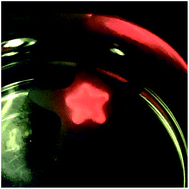当前位置:
X-MOL 学术
›
Chem. Sci.
›
论文详情
Our official English website, www.x-mol.net, welcomes your
feedback! (Note: you will need to create a separate account there.)
Platinum(II) non-covalent crosslinkers for supramolecular DNA hydrogels
Chemical Science ( IF 7.6 ) Pub Date : 2020/03/05 , DOI: 10.1039/c9sc05910e Kaka Zhang 1, 2, 3, 4 , Vivian Wing-Wah Yam 1, 2, 3, 4
Chemical Science ( IF 7.6 ) Pub Date : 2020/03/05 , DOI: 10.1039/c9sc05910e Kaka Zhang 1, 2, 3, 4 , Vivian Wing-Wah Yam 1, 2, 3, 4
Affiliation

|
Manipulation of non-covalent metal–metal interactions allows the fabrication of functional metallosupramolecular structures with diverse supramolecular behaviors. The majority of reported studies are mostly designed and governed by thermodynamics, with very few examples of metallosupramolecular systems exhibiting intriguing kinetics. Here we report a serendipitous finding of platinum(II) complexes serving as non-covalent crosslinkers for the fabrication of supramolecular DNA hydrogels. Upon mixing the alkynylplatinum(II) terpyridine complex with double-stranded DNA in aqueous solution, the platinum(II) complex molecules are found to first stack into columnar phases by metal–metal and π–π interactions, and then the columnar phases that carry multiple positive charges crosslink the negatively charged DNA strands to form supramolecular hydrogels with luminescence properties and excellent processability. Subsequent platinum(II) intercalation into DNA competes with the metal–metal and π–π interactions at the crosslinking points, switching on the spontaneous gel-to-sol transition. In the case of a chloro (2,6-bis(benzimidazol-2′-yl)pyridine)platinum(II) complex, with [Pt(bzimpy)Cl]+ serving as a non-covalent crosslinker where the metal–metal and π–π interactions outcompete platinum(II) intercalation, the intercalation-driven gel-to-sol transition pathway is blocked since the gel state is energetically more favorable than the sol state. Interestingly, the ligand exchange reaction of the chloro ligand in [Pt(bzimpy)Cl]+ with glutathione (GSH) has endowed the complexes with enhanced hydrophilicity, decreasing the planarity of the complexes, and turning off the metal–metal and π–π interactions at the crosslinking points, leading to GSH-triggered hydrogel dissociation.
中文翻译:

超分子DNA水凝胶的铂(II)非共价交联剂
非共价金属-金属相互作用的操纵允许制造具有多种超分子行为的功能性金属超分子结构。大多数报道的研究大多是由热力学设计和控制的,很少有金属超分子系统表现出令人感兴趣的动力学的例子。在这里,我们报告了意外发现的铂(II)配合物,用作制造超分子DNA水凝胶的非共价交联剂。在水溶液中混合炔基铂(II)吡啶和双链DNA络合物后,铂(II)发现复杂分子首先通过金属-金属和π-π相互作用堆叠成柱状相,然后带有多个正电荷的柱状相交联带负电荷的DNA链,形成具有发光特性和出色的可加工性的超分子水凝胶。随后插入到DNA中的铂(II)在交联点与金属-金属和π-π相互作用竞争,从而开启了自发的凝胶-溶胶转变。在氯(2,6-双(苯并咪唑-2'-基)吡啶)铂(II)配合物的情况下,[Pt(bzimpy)Cl] +可作为非共价交联剂,其中金属与金属π–π相互作用胜过铂(II)插层,由于凝胶态在能量上比溶胶态更有利,因此阻止了插层驱动的凝胶-溶胶过渡路径。有趣的是,[Pt(bzimpy)Cl] +中的氯配体与谷胱甘肽(GSH)的配体交换反应赋予了配合物更高的亲水性,降低了配合物的平面度,并关闭了金属-金属和π-π在交联点发生相互作用,导致GSH触发的水凝胶解离。
更新日期:2020-03-26
中文翻译:

超分子DNA水凝胶的铂(II)非共价交联剂
非共价金属-金属相互作用的操纵允许制造具有多种超分子行为的功能性金属超分子结构。大多数报道的研究大多是由热力学设计和控制的,很少有金属超分子系统表现出令人感兴趣的动力学的例子。在这里,我们报告了意外发现的铂(II)配合物,用作制造超分子DNA水凝胶的非共价交联剂。在水溶液中混合炔基铂(II)吡啶和双链DNA络合物后,铂(II)发现复杂分子首先通过金属-金属和π-π相互作用堆叠成柱状相,然后带有多个正电荷的柱状相交联带负电荷的DNA链,形成具有发光特性和出色的可加工性的超分子水凝胶。随后插入到DNA中的铂(II)在交联点与金属-金属和π-π相互作用竞争,从而开启了自发的凝胶-溶胶转变。在氯(2,6-双(苯并咪唑-2'-基)吡啶)铂(II)配合物的情况下,[Pt(bzimpy)Cl] +可作为非共价交联剂,其中金属与金属π–π相互作用胜过铂(II)插层,由于凝胶态在能量上比溶胶态更有利,因此阻止了插层驱动的凝胶-溶胶过渡路径。有趣的是,[Pt(bzimpy)Cl] +中的氯配体与谷胱甘肽(GSH)的配体交换反应赋予了配合物更高的亲水性,降低了配合物的平面度,并关闭了金属-金属和π-π在交联点发生相互作用,导致GSH触发的水凝胶解离。











































 京公网安备 11010802027423号
京公网安备 11010802027423号